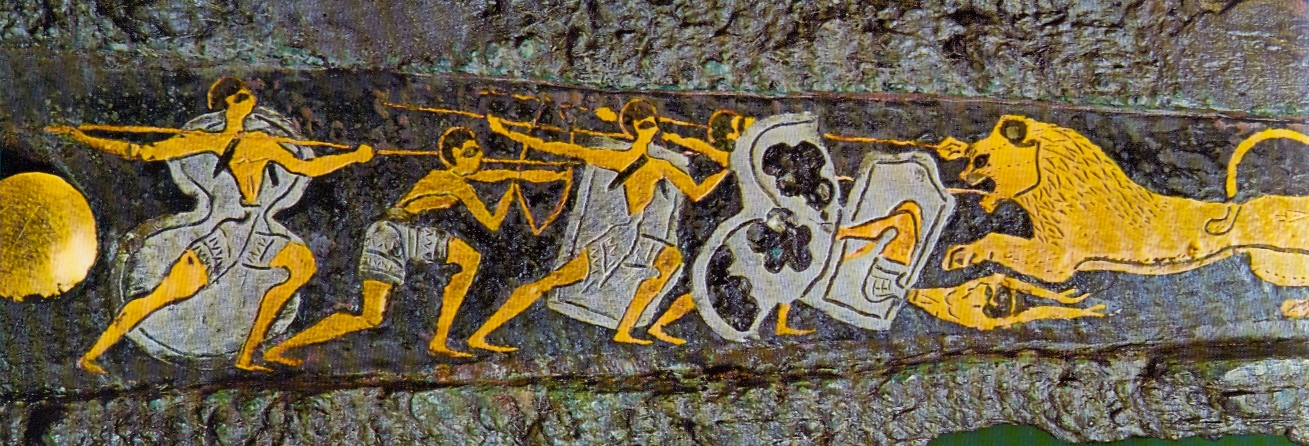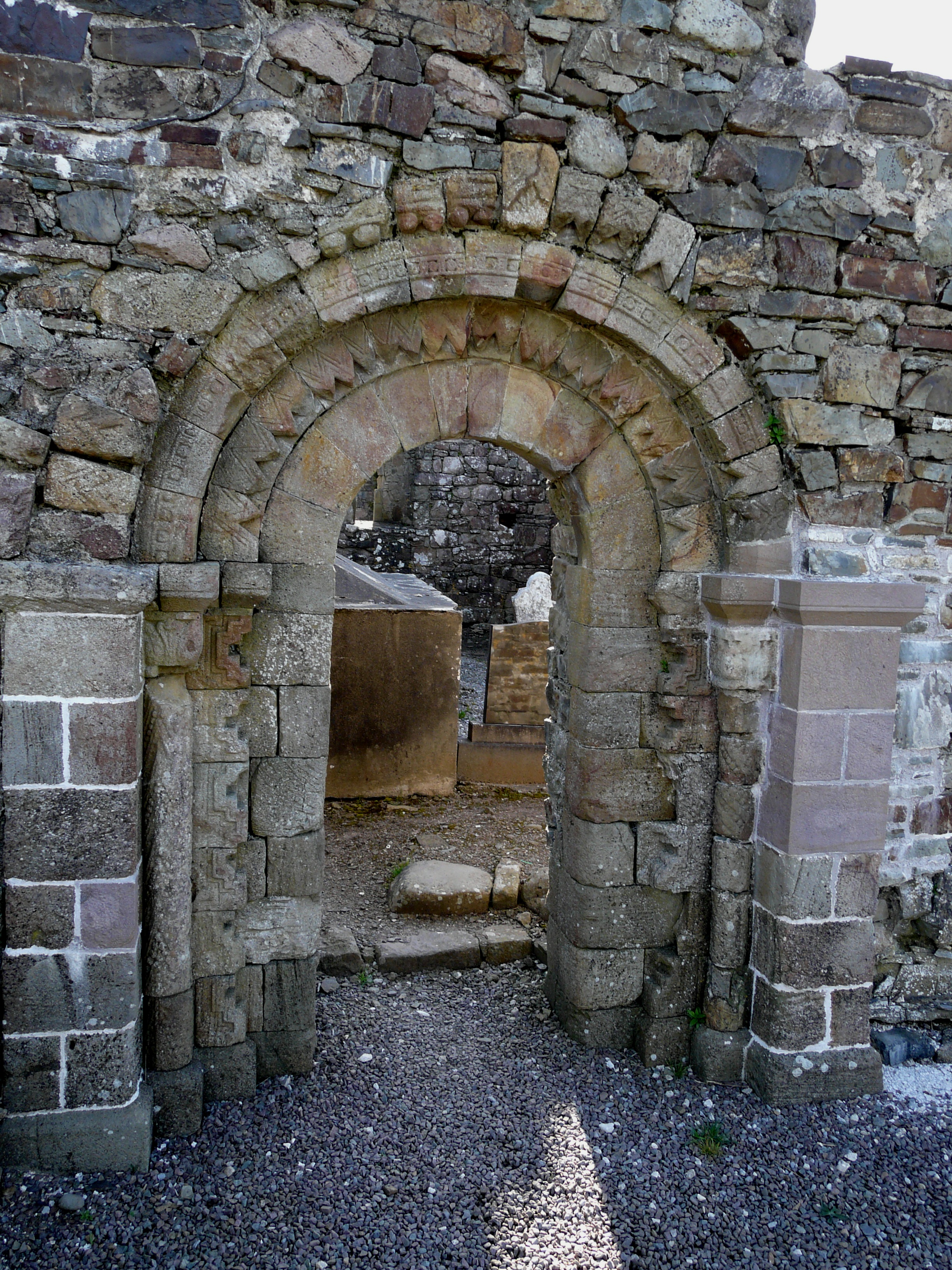|
River Laune Crozier
The River Laune Crozier (or Innisfallen or Dunloe Crozier) is a late 11th-century Insular crozier, now at the Archaeology branch of the National Museum of Ireland. The object would have been commissioned as a staff of office for a senior clergyman, most likely a bishop. It consists of a wooden core decorated with fitted bronze and silver metal plates. Although the metalwork is somewhat corroded in parts, it is fully intact and considered one of the finest surviving Irish examples, alongside those found at Clonmacnoise and Lismore. Its drop plate (that is, the hollow box-like extension at the end of the crook) shows a human figure in high relief with a long thin nose, spiral ears and a beard that radiates out and intertwines with the designs around him. It was discovered in 1867 deposited in the bed of the River Laune, by the Lakes of Killarney in County Kerry, by a fisherman who initially mistook it as either a salmon or a gun, before establishing it as a "curious handstick". It ... [...More Info...] [...Related Items...] OR: [Wikipedia] [Google] [Baidu] |
Niello
Niello is a black mixture, usually of sulphur, copper, silver, and lead, used as an inlay on engraved or etched metal, especially silver. It is added as a powder or paste, then fired until it melts or at least softens, and flows or is pushed into the engraved lines in the metal. It hardens and blackens when cool, and the niello on the flat surface is polished off to show the filled lines in black, contrasting with the polished metal (usually silver) around it. It may also be used with other metalworking techniques to cover larger areas, as seen in the sky in the diptych illustrated here. The metal where niello is to be placed is often roughened to provide a key. In many cases, especially in objects that have been buried underground, where the niello is now lost, the roughened surface indicates that it was once there. Statistical consideration Niello was used on a variety of objects including sword hilts, chalices, plates, horns, adornment for horses, jewellery such as bra ... [...More Info...] [...Related Items...] OR: [Wikipedia] [Google] [Baidu] |
Inlay
Inlay covers a range of techniques in sculpture and the decorative arts for inserting pieces of contrasting, often colored materials into depressions in a base object to form Ornament (art), ornament or pictures that normally are flush with the matrix. A great range of materials have been used both for the base or matrix and for the inlays inserted into it. Inlay is commonly used in the production of decorative furniture, where pieces of colored wood, precious metals or even diamonds are inserted into the surface of the carcass using various matrices including clear coats and varnishes. Lutherie inlays are frequently used as decoration and marking on musical instruments, particularly the smaller strings. Perhaps the most famous example of furniture inlay is that of Andre-Charles Boulle (11 November 1642 – 28 February 1732) which is known as Boulle Work and evolved in part from inlay produced in Italy during the late 15th century at the '' Studiolo'' for Federico da Monte ... [...More Info...] [...Related Items...] OR: [Wikipedia] [Google] [Baidu] |
Irish Annals
A number of Irish annals, of which the earliest was the Chronicle of Ireland, were compiled up to and shortly after the end of the 17th century. Annals were originally a means by which monks determined the yearly chronology of feast days. Over time, the obituaries of priests, abbots and bishops were added, along with that of notable political events. Non-Irish models include Bede's ''Chronica maiora'', Marcellinus Comes's ''Chronicle of Marcellinus'' and the '' Liber pontificalis''.Ó Corráin, "annals, Irish", p. 69. Chronology The origins of annalistic compilation can be traced to the occasional recording of notes and events in blank spaces between the '' latercus'', i.e. the 84-year Easter table adopted from Gaulish writer Sulpicius Severus (d. ''c''. 423). Extant Manuscript copies of extant annals include the following: * ''Annals of Boyle'' * ''Annals of Clonmacnoise'' * ''Annals of Connacht'' * '' Annals of Duiske'' * ''Annals of the Four Masters'' * ''Annals of Inisfall ... [...More Info...] [...Related Items...] OR: [Wikipedia] [Google] [Baidu] |
Finian Lobhar
Saint Finian the Leper ( ga, Saint Finian Lobhar) was an early Irish saint credited by some sources with founding a church and monastery at Innisfallen in Killarney. Life Saint Finian was a disciple of St. Columba. He was a strict Irish abbot, whose monks followed a vegetarian diet. For a period of time, he stayed in Clonmore, later becoming the abbot of Swords Abbey near Dublin. He may have returned to Clonmore in his later years, and was called ''Lobhar'', "The Leper". Following the custom, he acquired the name when he contracted leprosy from a young boy, whom he had cured of the disease. A conflicting source, however, says that he only cured the boy and did not contract leprosy himself. His feast day The calendar of saints is the traditional Christian method of organizing a liturgical year by associating each day with one or more saints and referring to the day as the feast day or feast of said saint. The word "feast" in this context d ... is 16 March. Notes Refe ... [...More Info...] [...Related Items...] OR: [Wikipedia] [Google] [Baidu] |
Aghadoe Cathedral
Aghadoe Cathedral was a church that may have been the seat of a bishop at Aghadoe, Ireland (later joined with the Bishopric of Ardfert). The now ruined cathedral overlooks the Lakes of Killarney from Aghadoe, a few miles from Killarney. Aghadoe may have been the site of a church as early as the seventh century, but extant remains are of a stone structure built in the eleventh and twelfth centuries. Scottish journalist Charles Mackay visited Famine Ireland in the summer of 1849 and traveled to Killarney. He comments extensively on the grounds around Aghadoe Cathedral and how they were being used as a burial site for famine victims from the local workhouse. Mackay notes that within the one-acre church grounds surrounding the cathedral, only a small corner was used for workhouse burials. He estimates that over the past three years, from 1846 to 1849, approximately 2,000 workhouse famine victims were buried here. '' Forty Years Recollections'' Charles Mackay, p. 2:89–93. Hist ... [...More Info...] [...Related Items...] OR: [Wikipedia] [Google] [Baidu] |
Balanced Innisfallen Abbey Front
In telecommunications and professional audio, a balanced line or balanced signal pair is a circuit consisting of two conductors of the same type, both of which have equal impedances along their lengths and equal impedances to ground and to other circuits. The chief advantage of the balanced line format is good rejection of common-mode noise and interference when fed to a differential device such as a transformer or differential amplifier.G. Ballou, ''Handbook for Sound Engineers'', Fifth Edition, Taylor & Francis, 2015, p. 1267–1268. As prevalent in sound recording and reproduction, balanced lines are referred to as balanced audio. Common forms of balanced line are twin-lead, used for radio frequency signals and twisted pair, used for lower frequencies. They are to be contrasted to unbalanced lines, such as coaxial cable, which is designed to have its return conductor connected to ground, or circuits whose return conductor actually is ground (see earth-return telegraph). Balanc ... [...More Info...] [...Related Items...] OR: [Wikipedia] [Google] [Baidu] |
Cross Of Cong
The ''Cross of Cong'' ( ga, Cros Chonga, "the yellow baculum") is an early 12th-century Irish Christian ornamented cusped processional cross, which was, as an inscription says, made for Tairrdelbach Ua Conchobair (d. 1156), King of Connacht and High King of Ireland to donate to the Cathedral church of the period that was located at Tuam, County Galway, Ireland. The cross was subsequently moved to Cong Abbey at Cong, County Mayo, from which it takes its name. It was designed to be placed on top of a staff and is also a reliquary, designed to hold a purported piece of the True Cross. This gave it additional importance as an object of reverence and was undoubtedly the reason for the object's elaborate beauty. The cross is displayed at the National Museum of Ireland, Dublin, having previously been in the Museum of the Royal Irish Academy, Dublin. It is considered one of finest examples of metalwork and decorative art of its period in Western Europe. Description The Cross of ... [...More Info...] [...Related Items...] OR: [Wikipedia] [Google] [Baidu] |
Royal Society Of Antiquaries Of Ireland
The Royal Society of Antiquaries of Ireland is a learned society based in Ireland, whose aims are "to preserve, examine and illustrate all ancient monuments and memorials of the arts, manners and customs of the past, as connected with the antiquities, language, literature and history of Ireland". Founded in 1849, it has a countrywide membership from all four provinces of Ireland. Anyone subscribing to the aims of the Society, subject to approval by Council, may be elected to membership. Current and past members have included historians, archaeologists and linguists, but the Society firmly believes in the importance of encouraging an informed general public, and many members are non-professionals. After the Society's move to Dublin in the 1890s, it came eventually to occupy the premises on Merrion Square, where it is still to be found. It now fulfills its original aims through the maintenance of its library and provision of lectures and excursions, as well as the continued publi ... [...More Info...] [...Related Items...] OR: [Wikipedia] [Google] [Baidu] |
Charles O'Sullivan
Charles O'Sullivan (22 August 1858, Ballyfinnane – 29 January 1927, Killarney) was an Irish Roman Catholic bishop. O'Sullivan was educated at St Patrick's College, Maynooth and ordained in 1884. He received the degree of Doctor of Divinity (DD). He was Bishop of Ardfert and Aghadoe The Bishop of Ardfert and Aghadoe (usually simply referred to as the Bishop of Ardfert) was an episcopal title which took its name after the village of Ardfert and townland of Aghadoe, both in County Kerry, Republic of Ireland. History The dioc ... from 1917 until his death. References 1858 births 1927 deaths 20th-century Roman Catholic bishops in Ireland Roman Catholic Bishops of Ardfert and Agahdoe Alumni of St Patrick's College, Maynooth Christian clergy from County Kerry {{Ireland-RC-bishop-stub ... [...More Info...] [...Related Items...] OR: [Wikipedia] [Google] [Baidu] |
Salmon
Salmon () is the common name for several list of commercially important fish species, commercially important species of euryhaline ray-finned fish from the family (biology), family Salmonidae, which are native to tributary, tributaries of the North Atlantic (genus ''Salmo'') and North Pacific (genus ''Oncorhynchus'') basin. Other closely related fish in the same family include trout, Salvelinus, char, Thymallus, grayling, Freshwater whitefish, whitefish, lenok and Hucho, taimen. Salmon are typically fish migration, anadromous: they hatch in the gravel stream bed, beds of shallow fresh water streams, migrate to the ocean as adults and live like sea fish, then return to fresh water to reproduce. However, populations of several species are restricted to fresh water throughout their lives. Folklore has it that the fish return to the exact spot where they hatched to spawn (biology), spawn, and tracking studies have shown this to be mostly true. A portion of a returning salmon run ma ... [...More Info...] [...Related Items...] OR: [Wikipedia] [Google] [Baidu] |
Killarney
Killarney ( ; ga, Cill Airne , meaning 'church of sloes') is a town in County Kerry, southwestern Ireland. The town is on the northeastern shore of Lough Leane, part of Killarney National Park, and is home to St Mary's Cathedral, Ross Castle, Muckross House and Abbey, the Lakes of Killarney, MacGillycuddy's Reeks, Purple Mountain, Mangerton Mountain, Paps Mountain, the Gap of Dunloe and Torc Waterfall. Its natural heritage, history and location on the Ring of Kerry make Killarney a popular tourist destination. Killarney won the Best Kept Town award in 2007, in a cross-border competition jointly organised by the Department of the Environment and the Northern Ireland Amenity Council. In 2011, it was named Ireland's tidiest town and the cleanest town in the country by Irish Business Against Litter. History Early history and development Killarney featured prominently in early Irish history, with religious settlements playing an important part of its recorded history. Its fi ... [...More Info...] [...Related Items...] OR: [Wikipedia] [Google] [Baidu] |
Interlace (art)
In the visual arts, interlace is a decorative element found in medieval art. In interlace, bands or portions of other motif (visual arts), motifs are looped, braided, and knotted in complex geometry, geometric patterns, often to fill a space. Interlacing is common in the Migration period art of Northern Europe, in the early medieval Insular art of Ireland and the British Isles, and Norse art of the Early Middle Ages, and in Islamic interlace patterns, Islamic art. Intricate braided and interlaced patterns, called ''plaits'' in British usage, first appeared in late Roman art in various parts of Europe, in mosaic floors and other media. Coptic art, Coptic manuscripts and textiles of 5th- and 6th-century Christian Egypt are decorated with broad-strand ribbon interlace ornament bearing a "striking resemblance" to the earliest types of knotwork found in the Insular art manuscripts of Ireland and the British Isles.Mitchell et al. 1977, p. 59 History and application Northern Europ ... [...More Info...] [...Related Items...] OR: [Wikipedia] [Google] [Baidu] |




.jpg)

